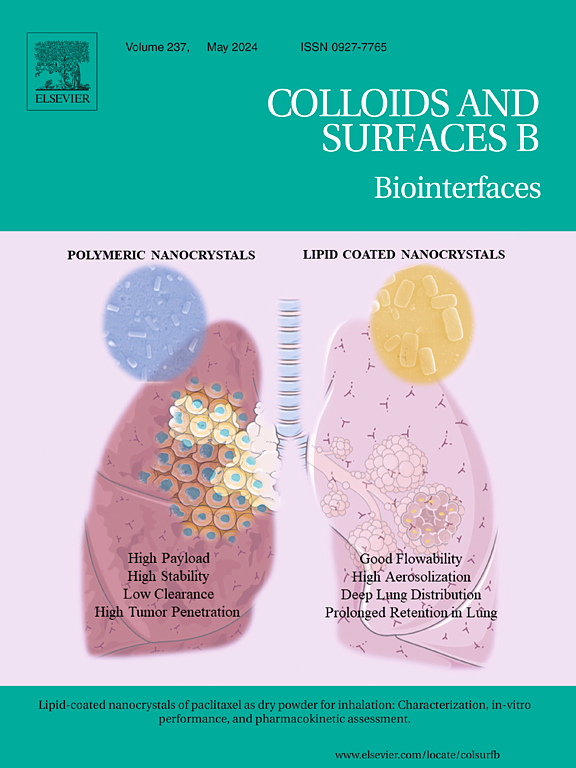Oxygen-boosted nanodrug for amplified ferroptosis-photodynamic immunotherapy together with PD-1 checkpoint blockade against triple-negative breast cancer
IF 5.4
2区 医学
Q1 BIOPHYSICS
引用次数: 0
Abstract
While photodynamic therapy (PDT) may augment immune checkpoint blockade in triple-negative breast cancer (TNBC), its effectiveness is constrained by tumor hypoxia and suboptimal immune activation. To address these challenges, an innovative nanodrug (HV NPs) has been developed for the targeted delivery of the photosensitizer verteporfin and hemin, utilizing human serum albumin as a delivery vehicle. The catalase-like activity of hemin alleviates the hypoxic conditions in the tumor microenvironment and boosts PDT. The HV NPs, when activated by a 635 nm laser, induce apoptosis and ferroptosis in tumor cells and facilitate the release of tumor-associated debris, which triggers immunogenic cell death and enhance tumor immunogenicity. Meanwhile, modulation of the hypoxic tumor microenvironment attenuates immunosuppressive cell infiltration, thereby enhancing antitumor immunity. This systemic immune response can be further enhanced by PD-1 blockade, thereby inhibiting both primary tumors and lung metastasis. Collectively, our study indicates that HV NPs-mediated oxygen-boosted PDT represents a promising strategy to enhance the efficacy of PD-1 checkpoint blockade immunotherapies in TNBC.
氧增强纳米药物用于放大铁凋亡-光动力免疫疗法联合PD-1检查点阻断治疗三阴性乳腺癌
虽然光动力疗法(PDT)可以增强三阴性乳腺癌(TNBC)的免疫检查点阻断,但其有效性受到肿瘤缺氧和次优免疫激活的限制。为了解决这些挑战,一种创新的纳米药物(HV NPs)已经被开发出来,用于靶向递送光敏剂维替泊芬和血红蛋白,利用人血清白蛋白作为递送载体。血红素的过氧化氢酶样活性缓解了肿瘤微环境中的缺氧条件,促进了PDT的发生。当HV NPs被635 nm激光激活时,可诱导肿瘤细胞凋亡和铁凋亡,促进肿瘤相关碎片的释放,从而触发免疫原性细胞死亡,增强肿瘤免疫原性。同时,低氧肿瘤微环境的调节可减弱免疫抑制细胞的浸润,从而增强抗肿瘤免疫。PD-1阻断可进一步增强这种全身免疫反应,从而抑制原发肿瘤和肺转移。总之,我们的研究表明,HV nps介导的氧促PDT代表了一种有希望的策略,可以增强PD-1检查点阻断免疫疗法在TNBC中的疗效。
本文章由计算机程序翻译,如有差异,请以英文原文为准。
求助全文
约1分钟内获得全文
求助全文
来源期刊

Colloids and Surfaces B: Biointerfaces
生物-材料科学:生物材料
CiteScore
11.10
自引率
3.40%
发文量
730
审稿时长
42 days
期刊介绍:
Colloids and Surfaces B: Biointerfaces is an international journal devoted to fundamental and applied research on colloid and interfacial phenomena in relation to systems of biological origin, having particular relevance to the medical, pharmaceutical, biotechnological, food and cosmetic fields.
Submissions that: (1) deal solely with biological phenomena and do not describe the physico-chemical or colloid-chemical background and/or mechanism of the phenomena, and (2) deal solely with colloid/interfacial phenomena and do not have appropriate biological content or relevance, are outside the scope of the journal and will not be considered for publication.
The journal publishes regular research papers, reviews, short communications and invited perspective articles, called BioInterface Perspectives. The BioInterface Perspective provide researchers the opportunity to review their own work, as well as provide insight into the work of others that inspired and influenced the author. Regular articles should have a maximum total length of 6,000 words. In addition, a (combined) maximum of 8 normal-sized figures and/or tables is allowed (so for instance 3 tables and 5 figures). For multiple-panel figures each set of two panels equates to one figure. Short communications should not exceed half of the above. It is required to give on the article cover page a short statistical summary of the article listing the total number of words and tables/figures.
 求助内容:
求助内容: 应助结果提醒方式:
应助结果提醒方式:


